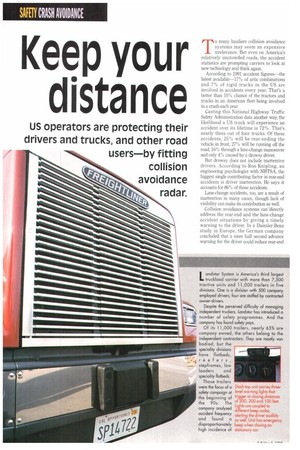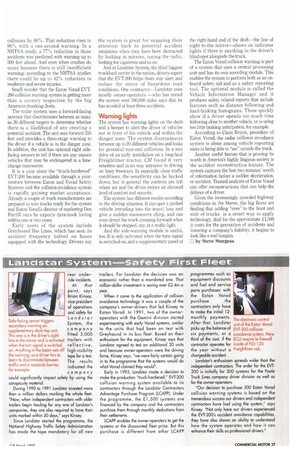Keep your distance
Page 38

Page 39

If you've noticed an error in this article please click here to report it so we can fix it.
To many hauliers collision avoidance systems may seem an expensive irrelevance. But even on America's relatively uncrowded roads, the accident statistics are prompting carriers to look at new technology and think again.
According to 1991 accident figures—the latest available-17% of artic combinations and 7% of rigid trucks in the US are involved in accidents every year. That's a better than 10% chance of the tractors and trucks in an American fleet being involved in a crash each year.
Casting this National Highway Traffic Safety Administration data another way, the likelihood a US truck will experience an accident over its lifetime is 72%. That's nearly three out of four trucks. Of these accidents, 25% will be rear-ending the vehicle in front, 27% will be running off the road, 16% through a lane-change manoeuvre and only 4% caused by a drowsy driver.
But drowsy does not include inattentive drivers. According to Ron Knipling, an engineering psychologist with NHTSA, the biggest single contributing factor in rear-end accidents is driver inattention. He says it accounts for 86% of those accidents.
Lane-change accidents, too, are a result of inattention in many cases, though lack of visibility can make its contribution as well.
Collision avoidance systems can 'directly address the rear-end and the lane-change accident situations by giving a timely warning to the driver. In a Daimler-Benz study in Europe, the German company concluded that a mere half second advance warning for the driver could reduce rear-end collisions by 60%. That reduction rises to 90% with a one-second warning. In a NHTSA study, a 77% reduction in these accidents was predicted with warning up to 300 feet ahead. And even when crashes do occur because there is still insufficient warning: according to the NHTSA studies there could be up to 42% reduction in moderate and severe injuries.
Small wonder that the Eaton Vorad EVT200 collision warning system is getting more than a cursory inspection by the big American trunking fleets.
The radar system uses a forward-facing antenna that discriminates between as many as 20 different targets to determine whether there is a likelihood of any creating a potential accident. The unit sees forward 350 feet and provides a three-stage warning to the driver if a vehicle is in the danger zone. In addition, the unit has optional right sidefacing sensors to tell if there are any unseen vehicles that may be endangered in a lanechange manoeuvre.
It is a year since the "truck-hardened" EVT-200 became available through a jointventure between Eaton and Vorad Safety Systems and the collision-avoidance system is rapidly gaining market acceptance. Already a couple of truck manufacturers are prepared to wire trucks ready for the system and Eaton Vorad's director of marketing Don Purtill says he expects data-book listing within one or two years.
Early users of the system include Greyhound Bus Lines, which has seen its accident frequency halved on buses equipped with the technology Drivers say the system is great for snapping their attention back to potential accident situations when they have been distracted by looking in mirrors, tuning the radio, looking for cigarettes and so on.
And at Landstar System, the third biggest truckload carrier in the nation, drivers report that the EVT-200 helps them stay alert and reduce the stress of hazardous road conditions. One contractor—Landstar uses mostly owner-operators —who has tested the system over 500,000 miles says that he has avoided at least three accidents.
Warning lights The system has warning lights on the dash and a beeper to alert the driver of vehicles out in front of his vehicle and within the danger zone. The system discriminates between up to 20 different vehicles and looks for potential rear-end collisions. In a test drive of an early installation on a long-haul Freightliner tractor, CM found it very sensitive and in no way intrusive in driving on busy freeways. In especially close traffic conditions, the sensitivity can be backed down, but in general the controls are left where set and the driver enjoys an elevated level of comfort and security.
The system has different modes according to the driving situation. It can spot a parked vehicle intruding into the travel lane and give a sudden manoeuvre chirp, and can even detect the truck creeping forward when it should be stopped, say, at a traffic light.
And the side-warning module is useful, too. It is only activated when the turn signal is switched on, and a supplementary panel at the right-hand end of the dash—the line of sight to the mirror—shows on indicator lights if there is anything in the driver's blind-spot alongside the truck.
The Eaton Vorad collision warning is part of a system that uses a central processing unit and has its own recording module. This enables the system to perform both as an onboard safety aid and as a safety reporting tool. The optional module is called the Vehicle Information Manager and it produces safety related reports that include features such as distance following and hard-braking histograms. These quickly show if a driver spends too much time following close to another vehicle, or is using too little braking anticipation, for example.
According to Chris Royan, president of Eaton Vorad, the radar collision avoidance system is alone among vehicle reporting units in being able to "see" outside the truck.
Another useful feature that is proving its worth in America's highly litigious society is the accident reconstruction feature. The system captures the last two minutes' worth of information before a sudden deceleration, or accident. Trained analysts at Eaton \brad can offer reconstructions that can help the defence of a driver.
Given the increasingly crowded highway conditions in the States, the big fleets are finding that adding "eyes" to the front and side of trucks is a smart way to apply technology And for the approximate 11,500 it costs for the prevention of accidents and lowering a company's liability, it begins to look like a real bargain.
by Steve Sturgess




























































































